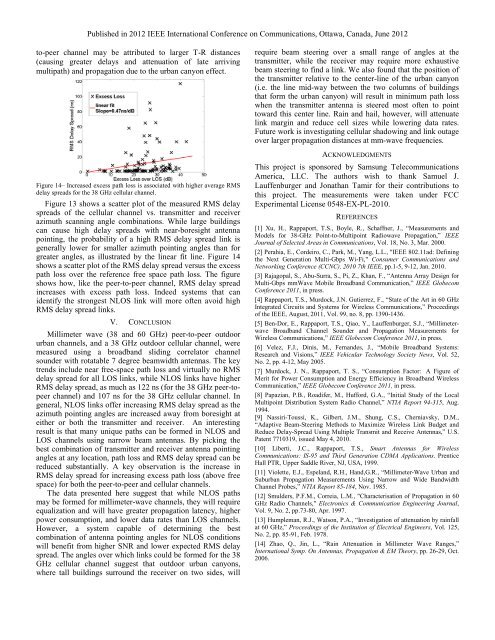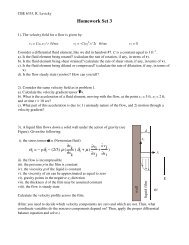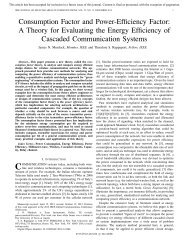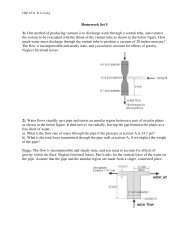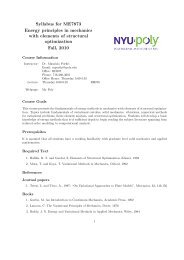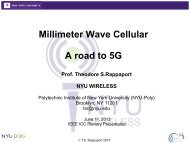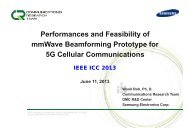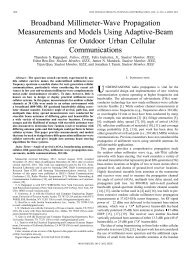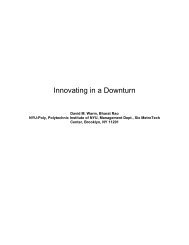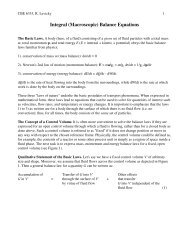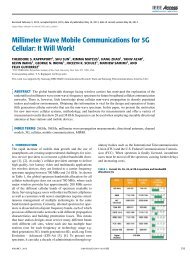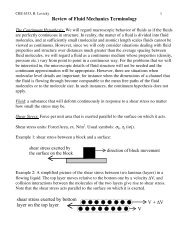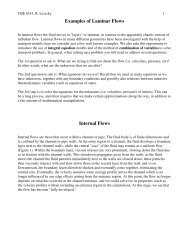38 GHz and 60 GHz Angle-dependent Propagation for Cellular ...
38 GHz and 60 GHz Angle-dependent Propagation for Cellular ...
38 GHz and 60 GHz Angle-dependent Propagation for Cellular ...
You also want an ePaper? Increase the reach of your titles
YUMPU automatically turns print PDFs into web optimized ePapers that Google loves.
Published in 2012 IEEE International Conference on Communications, Ottawa, Canada, June 2012to-peer channel may be attributed to larger T-R distances(causing greater delays <strong>and</strong> attenuation of late arrivingmultipath) <strong>and</strong> propagation due to the urban canyon effect.Figure 14– Increased excess path loss is associated with higher average RMSdelay spreads <strong>for</strong> the <strong>38</strong> <strong>GHz</strong> cellular channel.Figure 13 shows a scatter plot of the measured RMS delayspreads of the cellular channel vs. transmitter <strong>and</strong> receiverazimuth scanning angle combinations. While large buildingscan cause high delay spreads with near-boresight antennapointing, the probability of a high RMS delay spread link isgenerally lower <strong>for</strong> smaller azimuth pointing angles than <strong>for</strong>greater angles, as illustrated by the linear fit line. Figure 14shows a scatter plot of the RMS delay spread versus the excesspath loss over the reference free space path loss. The figureshows how, like the peer-to-peer channel, RMS delay spreadincreases with excess path loss. Indeed systems that canidentify the strongest NLOS link will more often avoid highRMS delay spread links.V. CONCLUSIONMillimeter wave (<strong>38</strong> <strong>and</strong> <strong>60</strong> <strong>GHz</strong>) peer-to-peer outdoorurban channels, <strong>and</strong> a <strong>38</strong> <strong>GHz</strong> outdoor cellular channel, weremeasured using a broadb<strong>and</strong> sliding correlator channelsounder with rotatable 7 degree beamwidth antennas. The keytrends include near free-space path loss <strong>and</strong> virtually no RMSdelay spread <strong>for</strong> all LOS links, while NLOS links have higherRMS delay spread, as much as 122 ns (<strong>for</strong> the <strong>38</strong> <strong>GHz</strong> peer-topeerchannel) <strong>and</strong> 107 ns <strong>for</strong> the <strong>38</strong> <strong>GHz</strong> cellular channel. Ingeneral, NLOS links offer increasing RMS delay spread as theazimuth pointing angles are increased away from boresight ateither or both the transmitter <strong>and</strong> receiver. An interestingresult is that many unique paths can be <strong>for</strong>med in NLOS <strong>and</strong>LOS channels using narrow beam antennas. By picking thebest combination of transmitter <strong>and</strong> receiver antenna pointingangles at any location, path loss <strong>and</strong> RMS delay spread can bereduced substantially. A key observation is the increase inRMS delay spread <strong>for</strong> increasing excess path loss (above freespace) <strong>for</strong> both the peer-to-peer <strong>and</strong> cellular channels.The data presented here suggest that while NLOS pathsmay be <strong>for</strong>med <strong>for</strong> millimeter-wave channels, they will requireequalization <strong>and</strong> will have greater propagation latency, higherpower consumption, <strong>and</strong> lower data rates than LOS channels.However, a system capable of determining the bestcombination of antenna pointing angles <strong>for</strong> NLOS conditionswill benefit from higher SNR <strong>and</strong> lower expected RMS delayspread. The angles over which links could be <strong>for</strong>med <strong>for</strong> the <strong>38</strong><strong>GHz</strong> cellular channel suggest that outdoor urban canyons,where tall buildings surround the receiver on two sides, willrequire beam steering over a small range of angles at thetransmitter, while the receiver may require more exhaustivebeam steering to find a link. We also found that the position ofthe transmitter relative to the center-line of the urban canyon(i.e. the line mid-way between the two columns of buildingsthat <strong>for</strong>m the urban canyon) will result in minimum path losswhen the transmitter antenna is steered most often to pointtoward this center line. Rain <strong>and</strong> hail, however, will attenuatelink margin <strong>and</strong> reduce cell sizes while lowering data rates.Future work is investigating cellular shadowing <strong>and</strong> link outageover larger propagation distances at mm-wave frequencies.ACKNOWLEDGMENTSThis project is sponsored by Samsung TelecommunicationsAmerica, LLC. The authors wish to thank Samuel J.Lauffenburger <strong>and</strong> Jonathan Tamir <strong>for</strong> their contributions tothis project. The measurements were taken under FCCExperimental License 0548-EX-PL-2010.REFERENCES[1] Xu, H., Rappaport, T.S., Boyle, R., Schaffner, J., “Measurements <strong>and</strong>Models <strong>for</strong> <strong>38</strong>-<strong>GHz</strong> Point-to-Multipoint Radiowave <strong>Propagation</strong>,” IEEEJournal of Selected Areas in Communications, Vol. 18, No. 3, Mar. 2000.[2] Perahia, E., Cordeiro, C., Park, M., Yang, L.L., "IEEE 802.11ad: Definingthe Next Generation Multi-Gbps Wi-Fi," Consumer Communications <strong>and</strong>Networking Conference (CCNC), 2010 7th IEEE, pp.1-5, 9-12, Jan. 2010.[3] Rajagopal, S., Abu-Surra, S., Pi, Z., Khan, F., “Antenna Array Design <strong>for</strong>Multi-Gbps mmWave Mobile Broadb<strong>and</strong> Communication,” IEEE GlobecomConference 2011, in press.[4] Rappaport, T.S., Murdock, J.N. Gutierrez, F., “State of the Art in <strong>60</strong> <strong>GHz</strong>Integrated Circuits <strong>and</strong> Systems <strong>for</strong> Wireless Communications,” Proceedingsof the IEEE, August, 2011, Vol. 99, no. 8, pp. 1390-1436.[5] Ben-Dor, E., Rappaport, T.S., Qiao, Y., Lauffenburger, S.J., “MillimeterwaveBroadb<strong>and</strong> Channel Sounder <strong>and</strong> <strong>Propagation</strong> Measurements <strong>for</strong>Wireless Communications,” IEEE Globecom Conference 2011, in press.[6] Velez, F.J., Dinis, M., Fern<strong>and</strong>es, J., “Mobile Broadb<strong>and</strong> Systems:Research <strong>and</strong> Visions,” IEEE Vehicular Technology Society News, Vol. 52,No. 2, pp. 4-12, May 2005.[7] Murdock, J. N., Rappaport, T. S., “Consumption Factor: A Figure ofMerit <strong>for</strong> Power Consumption <strong>and</strong> Energy Efficiency in Broadb<strong>and</strong> WirelessCommunication,” IEEE Globecom Conference 2011, in press.[8] Papazian, P.B., Roadifer, M., Huf<strong>for</strong>d, G.A., “Initial Study of the LocalMultipoint Distribution System Radio Channel,” NTIA Report 94-315, Aug.1994.[9] Nassiri-Toussi, K., Gilbert, J.M., Shung, C.S., Cherniavsky, D.M.,“Adaptive Beam-Steering Methods to Maximize Wireless Link Budget <strong>and</strong>Reduce Delay-Spread Using Multiple Transmit <strong>and</strong> Receive Antennas,” U.S.Patent 7710319, issued May 4, 2010.[10] Liberti, J.C., Rappaport, T.S., Smart Antennas <strong>for</strong> WirelessCommunications: IS-95 <strong>and</strong> Third Generation CDMA Applications. PrenticeHall PTR, Upper Saddle River, NJ, USA, 1999.[11] Violette, E.J., Espel<strong>and</strong>, R.H., H<strong>and</strong>,G.R., “Millimeter-Wave Urban <strong>and</strong>Suburban <strong>Propagation</strong> Measurements Using Narrow <strong>and</strong> Wide B<strong>and</strong>widthChannel Probes,” NTIA Report 85-184, Nov. 1985.[12] Smulders, P.F.M., Correia, L.M., "Characterisation of <strong>Propagation</strong> in <strong>60</strong><strong>GHz</strong> Radio Channels," Electronics & Communication Engineering Journal,Vol. 9, No. 2, pp.73-80, Apr. 1997.[13] Humpleman, R.J., Watson, P.A., “Investigation of attenuation by rainfallat <strong>60</strong> <strong>GHz</strong>,” Proceedings of the Institution of Electrical Engineers, Vol. 125,No. 2, pp. 85-91, Feb. 1978.[14] Zhao, Q., Jin, L., “Rain Attenuation in Millimeter Wave Ranges,”International Symp. On Antennas, <strong>Propagation</strong> & EM Theory, pp. 26-29, Oct.2006.


